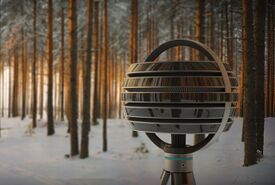Lytro Immerge

| |
|---|---|
| Developer | Lytro |
| Image | |
| Optics | |
Lytro Immerge is a 360-degree light field video camera from Lytro. It is claimed that it is the first gadget in the world that is able to capture the full light field volume and give users six degrees of freedom (6DoF).
Lytro Immerge comes with a dedicated server that is used to store and process all data captured by the camera and also a set of light field editing tools that integrate with all industry-standard video editors. First prototypes should be available to content creators in Q1 2016.
Features[edit]
Lytro Immerge is a product meant for professional filmmakers and content creators. The camera is a globe composed of five rings, which is able to capture a static 360-degree image of a scene. The spherical surface of the globe is made out of hundreds of individual sensors that capture and record every ray of light coming from the outside world. These sensors are able to detect where light rays hit the surface and also the direction which they are traveling. This gives the system enough data to faithfully recreate a model of the scene that is being viewed with six degrees of freedom of movement.
Even though the camera stays stationary, users can move closer and further away from any object in a scene. The first generation product will have only a limited range of movement, but this can improve with time by building bigger camera spheres and implementing various other configurations for different types of shooting situations.
Hardware[edit]
Lytro Immerge includes a configurable, dense light field camera array with professional cinematic video quality and a dedicated server for storage and processing of light field data with ultra-high bandwidth direct-to-disk capture ability. Each server should be able to hold approximately an hour of 360-degree light-field video footage. For the first time in history, a camera is able to capture the full light field volume and thus give consumers six degrees of freedom experience. A total of five layers full of 360-degree cameras and sensors allow for accurate horizontal and vertical parallax, which is needed for realistic incorporation of CGI elements in the video. Each layer has approximately three to four times the data and resolution of any existing VR camera. According to Lytro, this could translate to up to 2k per eye in VR headsets.
Software[edit]
Lytro has developed a set of light field plugins for standard visual effect tools like Nuke, Final Cut Pro, Adobe Premiere, and Avid Media Composer. These creations can be viewed on common virtual reality headsets and platforms by using a light field video playback engine from Lytro.